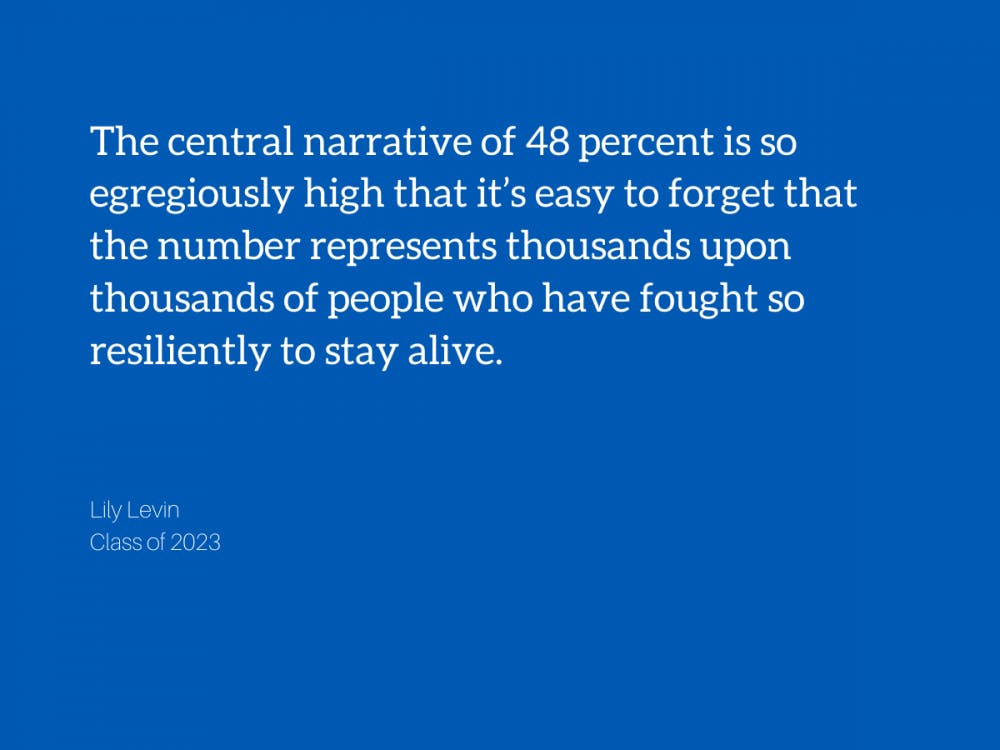In the first week of my Civic Engagement FOCUS class, we were instructed to write about one issue that distressed us most about our, thus far, limited perspective on campus culture. I finished my paper in fifteen minutes--there was not one single issue I, as a female-identifying student, was more aware of than lack of a certain culture: consent. It’s as subtle as a waist-grab at Shooters, a sudden hand-on-the-back at Devine’s, an unwanted and unspoken invitation to dance, marked by the drunken presence of a boy standing a bit too close. It’s as overt and violent as the 48 percent of undergraduate women--and this percentage is most likely under-representative--surveyed in 2018 reporting having been sexually assaulted since their enrollment at Duke.
And let me be clear: the 48 percent is not the only narrative, even if it is the most widely-known. More than 56 percent of female students with disabilities and 50 percent of GLB women (this term is exclusionary, not taking into account transgender and gender non-binary individuals) reported experiencing gender violence, and 14 percent of men reported having been sexually assaulted. (The percentage of men experiencing gender violence is probably much higher, given the heightened stigmatization of male-identifying victims.)
The 48 percent, the 14 percent, the 56 percent--all are whispered behind closed doors, defined by the intrinsic fear of being alone, masked by Duke’s high retention rates and gleaming Student Wellness Center. The central narrative of 48 percent is so egregiously high that it’s easy to forget that the number represents thousands upon thousands of people who have fought so resiliently to stay alive.
The “distressing issue” ended up becoming a project. Two classmates and I launched a school-mandated research initiative investigating effective methods to reduce sexual violence at Duke. Our first stop, logically, was the Duke Women’s Center.
But the Duke Women’s Center was nowhere to be found. I ambled across spray-painted white lines in the back of East Campus, past Wilson, through Marketplace, unaware, uncomfortable, and, as is the default first-year mentality--pretty darn lost. A friend finally pointed me in the right direction; as I stumbled around the back side of the blankly-labelled Crowell building, the inaccessibility of the location was tangible. After sifting through previous Chronicle articles, I discovered that the administration relocated the Duke Women’s Center in 2016 from a central area of West Campus to the not-so-central area of East Campus. In addition to this backyard location, the Women’s Center is situated in the same building as the Duke Office of Student Conduct, forcing some victims to associate Crowell with both the safe space of the Center and the dangerous space inhabited by their perpetrators.
This move shows Duke’s disregard for female-identifying students and victims of gender violence. We are cast aside, relegated to second-class status by our own administration. During our meeting with the Duke Women’s Center, we were given advice to guide our research. We’d broadened our Internet-digging to encompass plans and strategies of other institutions making strides to reduce on-campus sexual violence.
Other universities have stepped up. University of Illinois Urbana-Champaign, enrollment 44,087 (three times the size of Duke), requires all first-years to be present at an interactive discussion on sexual assault called First Year Campus Acquiantance Rape Education, or FYCARE, in order to register for classes. Tulane, after releasing a climate report of 41 percent of undergraduate women having experienced sexual assault since enrollment, launched a transparent All In initiative with resources and workshops for faculty, parents, professors, and students. Duke’s only comparative approach to reducing sexual violence is Sexual Assault Prevention for Undergraduates (SAPU). And while a step in the right direction, this course is online, barely mandated, sent to our “Other” Inbox, and not due until the end of Orientation Week--even though sexual assault rates spike among first-years at the beginning of the semester. To assess the stringency of the testing requirements, I did not complete SAPU Part Two. I was sent a singular follow-up email, lost in the Inbox jungle of club meeting dates and class assignments and weekly blasts.
The prioritization of this course is undoubtedly low. Therefore, the prioritization of the humanity of sexual assault survivors is undoubtedly low.
At Duke, the burden is placed on the Women’s Center and student-led initiatives to foster dialogue about the unique barriers faced by women of color, queer issues, and gender violence. The Duke Sexual Assault policy is comprehensive but hard to navigate, filled with legal jargon that may prevent some students from reporting. The general sentiment on campus is that the administration is not effectively preventing sexual violence and has little incentive to do so as long as the school’s reputation remains strong.
After compiling a 13-page paper on strategies of peer institutions to combat this college-wide issue, I am thoroughly convinced that our administrative methods are barely scratching the surface. And I am most certainly not the first person (nor among the first hundred people) to attempt to affect change on campus.
So where do we go from here? We, as students, start with our relationships. We start with the way we are practicing affirmative consent, even during messy makeout sessions in the middle of a sweaty dance floor. We start with repeating consent, consent, consent until it becomes not a buzzword, but a value. We reflect on our own standards of heteronormativity and definitions of femininity and masculinity. And we challenge Duke administration to live up to its word when it claims to protect our bodies, our mental health, and our lives.
Forty-eight percent is 48 percent too many survivors. Forty-eight percent too many voices silenced. Forty-eight percent too many lives forever changed. Because 48 percent is 48 percent too high.
Lily Levin is a Trinity first-year. Her column “overcaffeinated convictions” runs on alternate Fridays.
Get The Chronicle straight to your inbox
Signup for our weekly newsletter. Cancel at any time.

